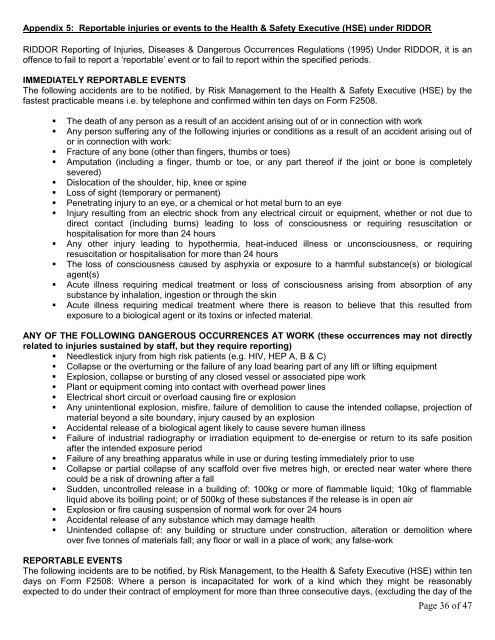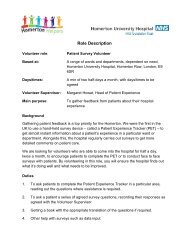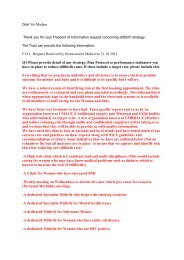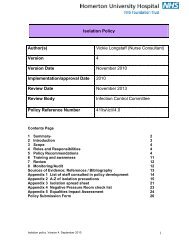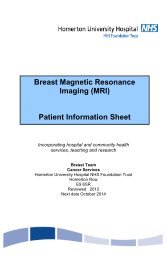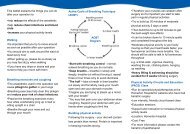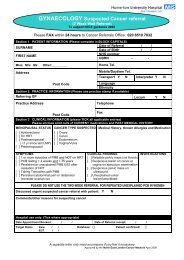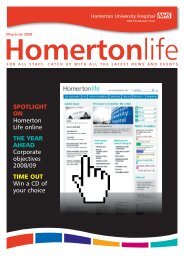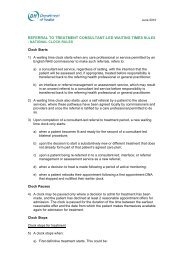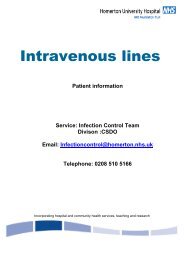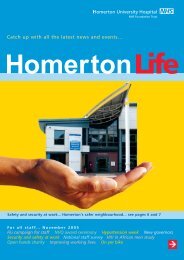Incident reporting policy - Homerton University Hospital
Incident reporting policy - Homerton University Hospital
Incident reporting policy - Homerton University Hospital
You also want an ePaper? Increase the reach of your titles
YUMPU automatically turns print PDFs into web optimized ePapers that Google loves.
Appendix 5: Reportable injuries or events to the Health & Safety Executive (HSE) under RIDDORRIDDOR Reporting of Injuries, Diseases & Dangerous Occurrences Regulations (1995) Under RIDDOR, it is anoffence to fail to report a „reportable‟ event or to fail to report within the specified periods.IMMEDIATELY REPORTABLE EVENTSThe following accidents are to be notified, by Risk Management to the Health & Safety Executive (HSE) by thefastest practicable means i.e. by telephone and confirmed within ten days on Form F2508.• The death of any person as a result of an accident arising out of or in connection with work• Any person suffering any of the following injuries or conditions as a result of an accident arising out ofor in connection with work:• Fracture of any bone (other than fingers, thumbs or toes)• Amputation (including a finger, thumb or toe, or any part thereof if the joint or bone is completelysevered)• Dislocation of the shoulder, hip, knee or spine• Loss of sight (temporary or permanent)• Penetrating injury to an eye, or a chemical or hot metal burn to an eye• Injury resulting from an electric shock from any electrical circuit or equipment, whether or not due todirect contact (including burns) leading to loss of consciousness or requiring resuscitation orhospitalisation for more than 24 hours• Any other injury leading to hypothermia, heat-induced illness or unconsciousness, or requiringresuscitation or hospitalisation for more than 24 hours• The loss of consciousness caused by asphyxia or exposure to a harmful substance(s) or biologicalagent(s)• Acute illness requiring medical treatment or loss of consciousness arising from absorption of anysubstance by inhalation, ingestion or through the skin• Acute illness requiring medical treatment where there is reason to believe that this resulted fromexposure to a biological agent or its toxins or infected material.ANY OF THE FOLLOWING DANGEROUS OCCURRENCES AT WORK (these occurrences may not directlyrelated to injuries sustained by staff, but they require <strong>reporting</strong>)• Needlestick injury from high risk patients (e.g. HIV, HEP A, B & C)• Collapse or the overturning or the failure of any load bearing part of any lift or lifting equipment• Explosion, collapse or bursting of any closed vessel or associated pipe work• Plant or equipment coming into contact with overhead power lines• Electrical short circuit or overload causing fire or explosion• Any unintentional explosion, misfire, failure of demolition to cause the intended collapse, projection ofmaterial beyond a site boundary, injury caused by an explosion• Accidental release of a biological agent likely to cause severe human illness• Failure of industrial radiography or irradiation equipment to de-energise or return to its safe positionafter the intended exposure period• Failure of any breathing apparatus while in use or during testing immediately prior to use• Collapse or partial collapse of any scaffold over five metres high, or erected near water where therecould be a risk of drowning after a fall• Sudden, uncontrolled release in a building of: 100kg or more of flammable liquid; 10kg of flammableliquid above its boiling point; or of 500kg of these substances if the release is in open air• Explosion or fire causing suspension of normal work for over 24 hours• Accidental release of any substance which may damage health• Unintended collapse of: any building or structure under construction, alteration or demolition whereover five tonnes of materials fall; any floor or wall in a place of work; any false-workREPORTABLE EVENTSThe following incidents are to be notified, by Risk Management, to the Health & Safety Executive (HSE) within tendays on Form F2508: Where a person is incapacitated for work of a kind which they might be reasonablyexpected to do under their contract of employment for more than three consecutive days, (excluding the day of thePage 36 of 47


